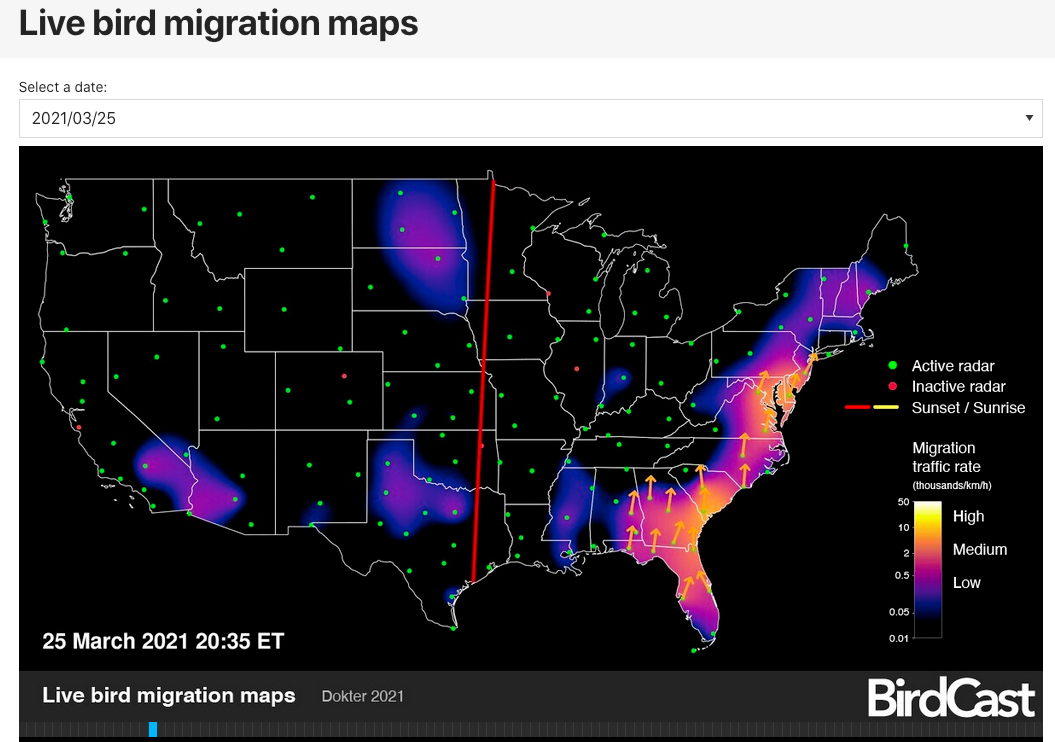
In Focus: Wild Bird Migration!
Share
-A Guide to Spring Bird Migration-

Have you spotted any different birds in your backyard lately? You may see new visitors to your feeding station or old friends passing through as we head into spring.
With longer and warmer days, our thoughts might turn to days out and enjoying time outside, but in the world of birds, the start of spring means the race is on to get to suitable breeding grounds. The spring migration has started.
Bird migration is one of the natural wonders of the world. At any time, somewhere around the world, a species of birds will be starting a journey. In the springtime, migration occurs in a smaller time window than at other times of the year, providing a great spectacle. As the days get longer and warmer, many birds have to begin long journeys to get to their summer breeding grounds in time to mate and bring up their young before going through the whole process in reverse in the cooler months.
Why Do Birds Migrate?
Migration is all about survival. As the seasons change, different areas will have more appropriate resources for birds to thrive. All birds need to ensure they have an adequate food supply, the right nesting sites, and suitable temperatures.
Where Do Birds Migrate To?
Generally, in the spring, birds are traveling from South to North. Some birds travel much greater distances than others, but it's a remarkable feat of endurance for all birds.
Amazingly, it is possible to see live tracking of bird migration at Birdcast. They use existing weather surveillance radar to collect and map birds' movements for scientific research and general interest. At the moment, you can see on the live map how birds are moving from south to north along their coastal migration pathways. Seeing the real-time bird tracking information gives a new perspective on bird migration.

Migration - Fun Facts
Bird migration isn't just a story of flight. Penguins swim long distances, and birds like Emus will take great walks to reach suitable habitats.
Over a lifetime, a bird can cover huge distances. The Manx Shearwater can live for over 50 years, and in that time, they can travel 5 million miles, migrating from Europe to the Falkland Islands.
The longest single migration distance is covered by the Arctic Tern when it travels from the Arctic to the Antarctic every year.



Good Places to See Spring Migration
The Great Lakes Region between Canada and North America can be fantastic for spotting birds during the spring migration. The whole area covers 94,000 square miles and consists of wetlands, forests, and prime habitat for flight weary birds to rest and recharge. Mid to late May is a good time to spot songbirds there on their spring migration.
Another good place for spring bird spotting is Central Park, New York City. With over 800 acres of space and some densely wooded areas, it attracts many spring migrants passing through. Up to 30 different species of warblers will use this area as a stopping-off point before moving further north in the spring.
The great thing about bird spotting is you can do it almost anywhere, and a backyard feeding station will enable you to see a variety of birds without even leaving your own home.
The Finch Family
Members of the finch family of birds are always popular visitors to backyards because of their beautiful plumage and song.
Many finches will migrate north in the spring to their summer breeding grounds in Canada or Alaska. They tend to move in flocks and will stop to feed in groups. Providing smaller seeds in garden feeders will help attract various finches to your backyard.
It's worth noting that not all finches will migrate every year. You might see finches seasonally as they're passing through, or it might be a year when you see lots of finches or very few.
You might be lucky enough to see two particular finches at your backyard feeder at the moment, the Pine Siskin and the Red Poll.
Pine Siskins and Red Polls
These are both small finches similar in size to a house sparrow. The Pine Siskin might even be mistaken for a sparrow at first sight because of its mottled brown coloring, but on closer inspection, the yellow edging to the wings and tail make it distinctively different.
The Common Red Poll, meanwhile, has a similar brown mixed plumage but without the yellow edging. The small red patch on its crown helps to identify it, and it has a slightly smaller bill than the Pine Siskin.
Both Redpolls and Pine Siskins eat smaller seeds such as thistle and nyjer seeds, perfect for their small bills. They may also eat black oil sunflower seeds or scavenge opened seeds left behind by larger-billed birds.


Photos: Top; Common Redpoll
The Importance of Your Bird Feeding Station
The more we know about migration, the more amazing it seems. Birds have to use their skills to know when to start their journeys, navigate, and then have the stamina to fly great distances. Along the way, they will face many threats, including the loss of wild feeding habitats.
Backyard bird feeding can provide vital feeding habitats for spring migrating birds. Concentrate on providing a regular supply of good quality seed and fresh drinking water nearby, and keep watching to see which birds will come. Everyone can play a part in spring migration and help support our wild bird populations while enjoying the spectacle provided by our beautiful and fascinating wild birds.
(Photo at article top: Blue Tit)
A small percentage of blue tits choose to head to the south or east coast in the winter, there they join some Northern European birds that prefer our winter climate to their own.
